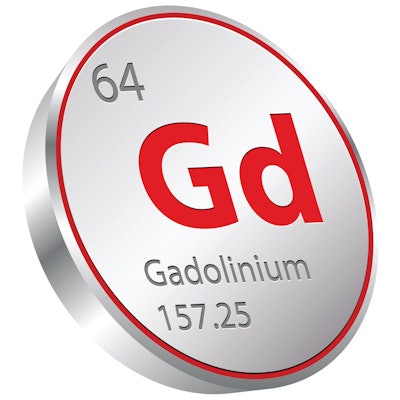
A new survey of 63 wastewater plants in Switzerland has detected high concentrations of gadolinium. It found that selected sewage samples were linked with the release of gadolinium-based contrast agents from hospitals and production outlets.
Around 80% of the total gadolinium content originated from industrial sources in the Ramsen wastewater treatment plant (WWTP) near Lake Constance on the German-Swiss border, researchers from the Swiss Federal Institute of Aquatic Science and Technology (Eawag) noted in a statement issued by Eawag on 11 March. The plant treats wastewater from the town of Singen in Germany, where a cancer hospital with MRI facilities (Hegau-Bodensee-Klinikum Singen) is located. The region is also home to industries that produce large quantities of gadolinium-based contrast agents.
 Researchers think gadolinium found in treatment plants near Lake Constance originates from the MRI unit at the Hegau-Bodensee-Klinikum Singen cancer hospital. Photo courtesy of wochenblatt.de.
Researchers think gadolinium found in treatment plants near Lake Constance originates from the MRI unit at the Hegau-Bodensee-Klinikum Singen cancer hospital. Photo courtesy of wochenblatt.de."The findings therefore confirm the previous assumption that the gadolinium found in sewage sludge can be traced back to the production and use of contrast agents. Appropriate measures to reduce the input of industrial gadolinium into wastewater by industry have already been taken and will lead to a significant reduction in the gadolinium load," the authors noted.
Total amounts of industrial gadolinium in the inflow and in the effluent of the 63 WWTPs were estimated based on the gadolinium concentrations in the sewage sludge and assuming 10% removal during the wastewater treatment.
The results indicate that in total, about 110 kg of gadolinium are discharged annually to the 63 WWTPs. Around 100 kg is released to the surface waters and 11 kg remains in the sludge. Of this 11 kg, about 80% can be assigned to one single WWTP (9 kg estimated for the sludge in the WWTP of Ramsen), corresponding to a discharge of 90 kg to the surface water.
The research team stated that "rare earth metals are not used on a large scale, but come from highly-specialized applications in industry." The highest concentrations were for cerium, which is often used as an abrasive material by industry. The team estimates that over four metric tons of cerium end up in wastewater treatment plants every year, half of which comes from industrial applications. The majority (95%) remains in the sewage sludge, but the remainder manages to get into the environment.
"Elevated cerium concentrations will be found in lakes, rivers, and groundwater in the near future," the scientists said, adding that high concentrations of lanthanum were also detected in sewage sludge at all Swiss treatment plants.
 Elements like cerium (Ce) and gadolinium (Gd) enter wastewater treatment plants (WWTPs) via wastewater. A large part of the cerium is separated in the sewage sludge, but almost no gadolinium is retained in the WWTP; it flows into the aquatic environment with the treated wastewater. Figure courtesy of Ralf Kägi, PhD, Eawag.
Elements like cerium (Ce) and gadolinium (Gd) enter wastewater treatment plants (WWTPs) via wastewater. A large part of the cerium is separated in the sewage sludge, but almost no gadolinium is retained in the WWTP; it flows into the aquatic environment with the treated wastewater. Figure courtesy of Ralf Kägi, PhD, Eawag.The team believes that biological processes could be responsible for the high levels of lanthanum in sewage sludge but the use of lanthanum-enriched fertilizers in agriculture may also be a factor.
According to a report on swissinfo.ch news website, lead author Ralf Kägi, PhD, a researcher in the department of process engineering at Eawag, said that the current concentrations of the rare earth metals found at Swiss sewage plants were not harmful to humans or the environment.
"The value of our study is in the identification of individual hotspots which may even motivate the responsible industry to recycle their materials more efficiently," he noted.
The full study was posted online on 13 February by the Water Research X journal.



















